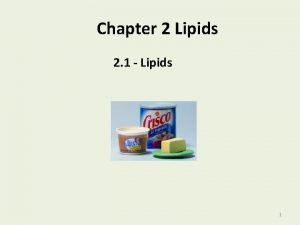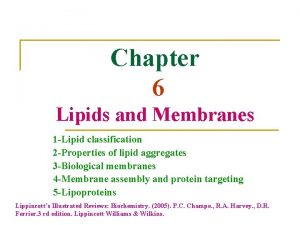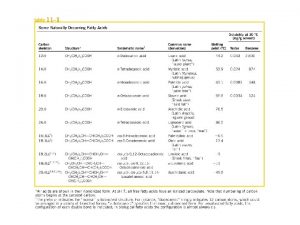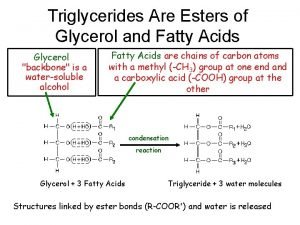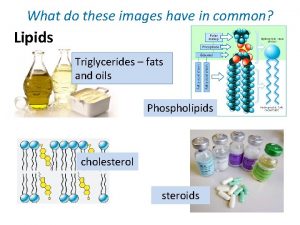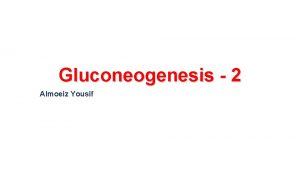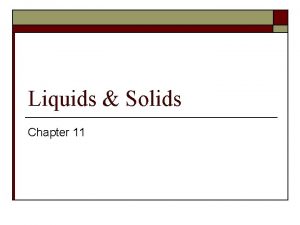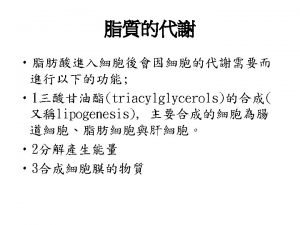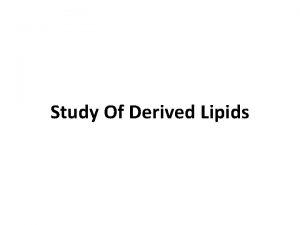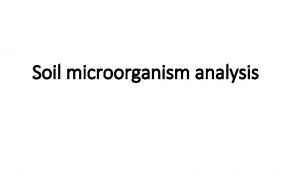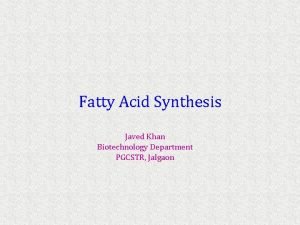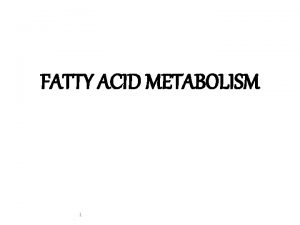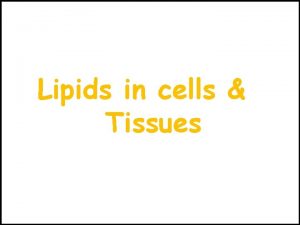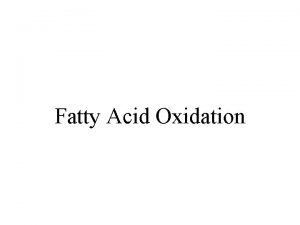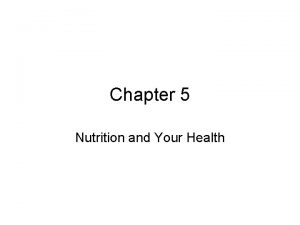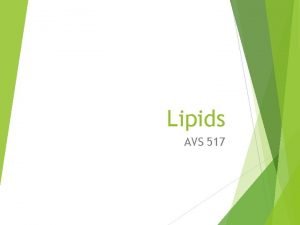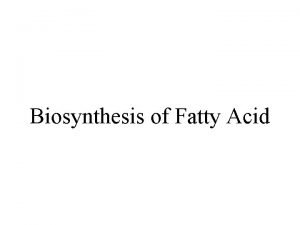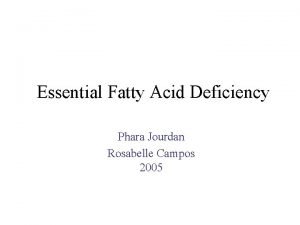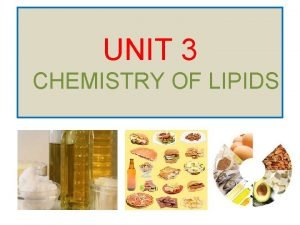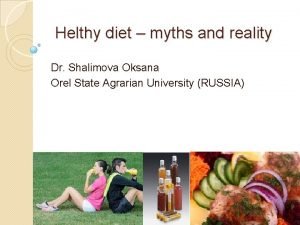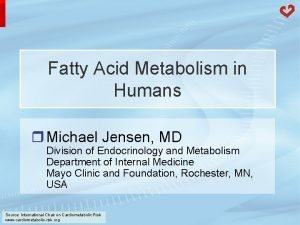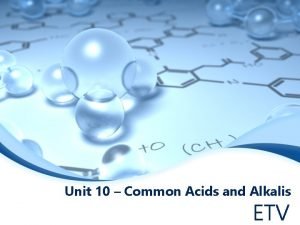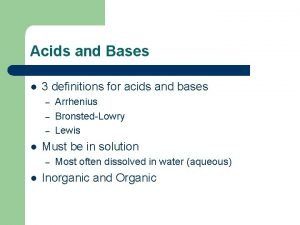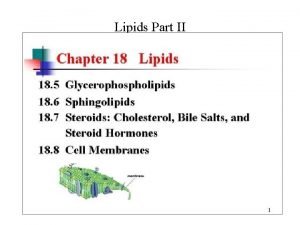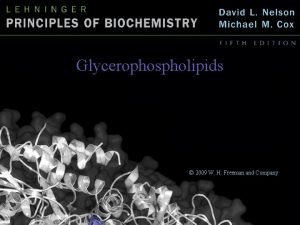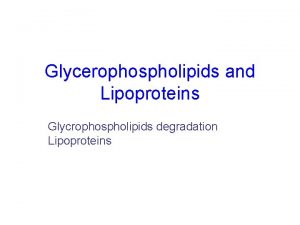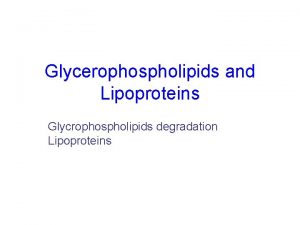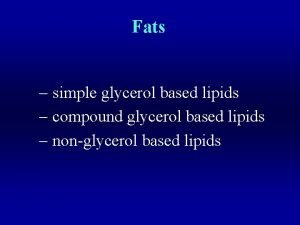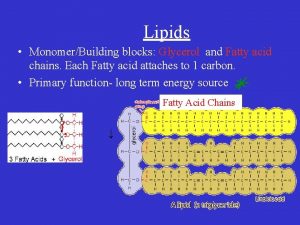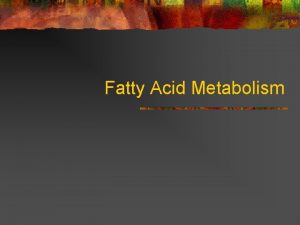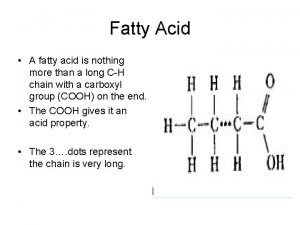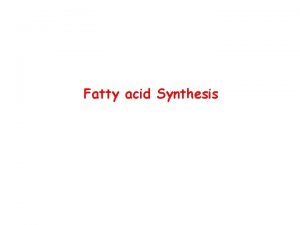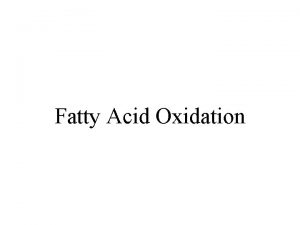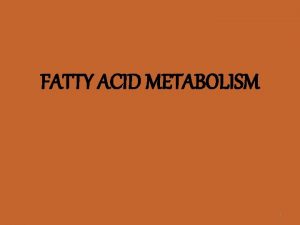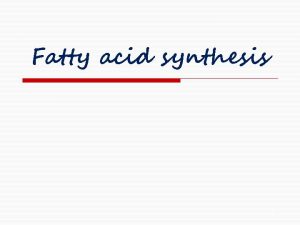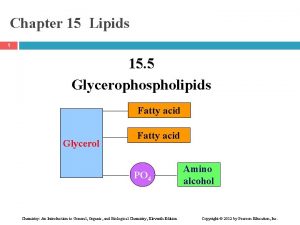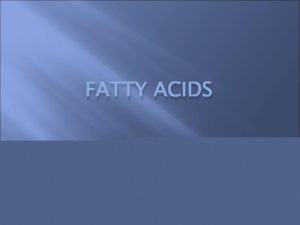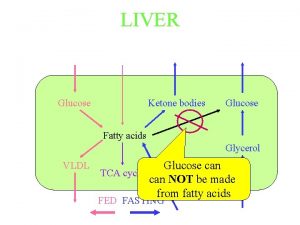15 5 Glycerophospholipids Fatty acid Glycerol Fatty acid





























- Slides: 29

15. 5 Glycerophospholipids Fatty acid Glycerol Fatty acid PO 4 Amino alcohol 1

Glycerophospholipids are • the most abundant lipids in cell membranes. • composed of glycerol, two fatty acids, phosphate, and an amino alcohol. Fatty acid Glycerol Fatty acid PO 4 Amino alcohol 2

Polarity of Glycerophospholipids A glycerophospholipid has • two nonpolar fatty acid chains. • A phosphate group and a polar amino alcohol. CH 3 │+ + HO−CH 2−N−CH 3 HO−CH 2−NH 3 │ choline CH 3 ethanolamine + NH 3 │ HO−CH 2−CH−COO− Amino alcohols serine 3

Structure and Polarity of A Glycerophospholipid 4

Lecithin and Cephalin Lecithin and cephalin are glycerophospholipids • abundant in brain and nerve tissues. • found in egg yolk, wheat germ, and yeast. 5

There are different kinds of head group: 6

15. 6 Steroids: Cholesterol, and Steroid Hormones Copyright © 2005 by Pearson Education, Inc. Publishing as Benjamin Cummings 7

Steroid Nucleus A steroid nucleus consists of • 3 cyclohexane rings. • 1 cyclopentane ring. • no fatty acids. steroid nucleus 8

Cholesterol • is the most abundant steroid in the body. • has methyl CH 3 - groups, alkyl chain, and -OH attached to the steroid nucleus. 9

Cholesterol in the Body Cholesterol • is obtained from meats, milk, and eggs. • is synthesized in the liver. • is needed for cell membranes, brain and nerve tissue, steroid hormones, and Vitamin D. • clogs arteries when high levels form plaque. A normal, open artery. An artery clogged by cholesterol plaque 10

Cholesterol in Foods Cholesterol • is considered elevated if plasma cholesterol exceeds 200 mg/d. L. • is synthesized in the liver and obtained from foods. 11

LIPID TRANSPORT Lipoproteins • Lipids are transported in the blood as lipoproteins • are soluble in water because the surface consists of polar lipids. 12

• Combine lipids with proteins and phospholipids. Lipids: Cholesterol Apolipoproteins + Cholesteryl esters lipoproteins Triacylglycerols Phospholids Lipid transport 13

14

There are 4 types of lipoprotein • The lipoprotein formed depends on the constituent protein and lipids protein triglyceride Chylo VLDL HDL 15

Composition of lipoproteins 16

17

INTESTINE TG TG INTESTINAL EPITHELIAL CELL LYMPH/ BLOOD Bile salts (emuslification) TG Lipases Cholesterol apolipoproteins Fatty acids glycerol Lipid transport TG chylomicrons 18

CMCONS TG LIVER Cholesterol VLDL HDL Cholesterol -esters Fatty acids albumin lymph TG Cholesterolesters TG TG GONADS ADRENALS TISSUES Lipid transport ADIPOSE MUSCLE LDL Cholesterol-esters 19

Fat cell 20

Steroid Hormones Steroid hormones are • chemical messengers in cells. • sex hormones. Androgens in males (testosterone) Estrogens in females (estradiol) • Adrenocortical hormones from adrenal glands. mineralocorticoids (electrolyte balance) glucocorticoids regulate glucose level 21

Steroid Hormones Steroid hormones • are produced from cholesterol. • include sex hormones such as androgens (testosterone) in males and estrogens (estradiol) in females. 22

Adrenal Corticosteroids Steroid hormones called adrenal corticosteroids • are produced by the adrenal glands located on the top of each kidney. • include aldosterone, which regulates electrolytes and water balance by the kidneys. • include cortisone, a glucocorticoid, which increases blood glucose level and stimulates the synthesis of glycogen in the liver. 23

Anabolic Steroids Anabolic steroids • are derivatives of testosterone. • are used illegally to increase muscle mass. • have side effects including fluid retention, hair growth, sleep disturbance, and liver damage. 24

Adrenal Corticosteroids 25

15. 7 Cell Membranes Copyright © 2005 by Pearson Education, Inc. Publishing as Benjamin Cummings 26

Cell Membranes Cell membranes • separate cellular contents from the external environment. • consist of a lipid bilayer made of two rows of phospholipids. • have an inner portion made of the nonpolar tails of phospholipids with the polar heads at the outer and inner surfaces. 27

Fluid Mosaic Model of Cell Membranes The lipid bilayer • contains proteins, carbohydrates, and cholesterol. has unsaturated fatty acids that make cell membranes fluid-like rather than rigid. • has proteins and carbohydrates on the surface that communicate with hormones and neurotransmitters. • 28

Fluid Mosaic Model of Cell Membranes 29
 Glycerol fatty acid
Glycerol fatty acid Glycerophospholipids
Glycerophospholipids Glycerophospholipids
Glycerophospholipids Formation of triacylglycerol
Formation of triacylglycerol What are triglycerides
What are triglycerides Glycerol to glucose
Glycerol to glucose Surfactant examples
Surfactant examples Weight and density formula
Weight and density formula Viscosity of glycerol
Viscosity of glycerol Glycerol combustion
Glycerol combustion Glycerol acetone
Glycerol acetone Glycerol to glucose
Glycerol to glucose Nomenclature of saturated fatty acids
Nomenclature of saturated fatty acids Plfa soil test
Plfa soil test Fatty acid synthesis
Fatty acid synthesis Fatty acid synthesis steps
Fatty acid synthesis steps Miscellaneous lipids
Miscellaneous lipids Acetylco a
Acetylco a Define saturated fatty acid
Define saturated fatty acid Chapter 5 lesson 1 health
Chapter 5 lesson 1 health Conclusion of lipids
Conclusion of lipids Fatty acid synthesis
Fatty acid synthesis Beta oxidation of fatty acid
Beta oxidation of fatty acid Fatty acid deficiency
Fatty acid deficiency Chemical properties of fatty acid
Chemical properties of fatty acid What is essential fatty acid
What is essential fatty acid Free fatty acids vs triglycerides
Free fatty acids vs triglycerides 9-which acid is not considered a strong acid?
9-which acid is not considered a strong acid? Acid fast and non acid fast bacteria
Acid fast and non acid fast bacteria Is chloric acid a strong acid
Is chloric acid a strong acid
